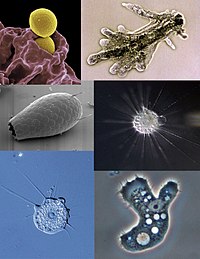
Photo from wikipedia
Background Despite the global distribution of the intestinal protozoan Dientamoeba fragilis, its clinical picture remains unclear. This results from underdiagnosis: microscopic screening methods either lack sensitivity (wet preparation) or fail… Click to show full abstract
Background Despite the global distribution of the intestinal protozoan Dientamoeba fragilis, its clinical picture remains unclear. This results from underdiagnosis: microscopic screening methods either lack sensitivity (wet preparation) or fail to reveal Dientamoeba (formalin-fixed sample). Aim In a retrospective study setting, we characterised the clinical picture of dientamoebiasis and compared it with giardiasis. In addition, we evaluated an improved approach to formalin-fixed samples for suitability in Dientamoeba diagnostics. Methods This study comprised four parts: (i) a descriptive part scrutinising rates of Dientamoeba findings; (ii) a methodological part analysing an approach to detect Dientamoeba-like structures in formalin samples; (iii) a clinical part comparing demographics and symptoms between patients with dientamoebiasis (n = 352) and giardiasis (n = 272), and (iv) a therapeutic part (n = 89 patients) investigating correlation between faecal eradication and clinical improvement. Results The rate of Dientamoeba findings increased 20-fold after introducing criteria for Dientamoeba-like structures in formalin-fixed samples (88.9% sensitivity and 83.3% specificity). A further increase was seen after implementing faecal PCR. Compared with patients with giardiasis, the symptoms in the Dientamoeba group lasted longer and more often included abdominal pain, cramping, faecal urgency and loose rather than watery stools. Resolved symptoms correlated with successful faecal eradication (p < 0.001). Conclusions Previously underdiagnosed, Dientamoeba has become the most frequently recorded pathogenic enteroparasite in Finland. This presumably results from improved diagnostics with either PCR or detection of Dientamoeba-like structures in formalin-fixed samples, an approach applicable also in resource-poor settings. Symptoms of dientamoebiasis differ slightly from those of giardiasis; patients with distressing symptoms require treatment.
Journal Title: Eurosurveillance
Year Published: 2019
Link to full text (if available)
Share on Social Media: Sign Up to like & get
recommendations!